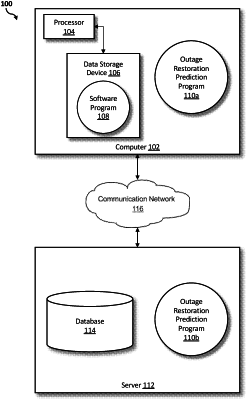| CPC G06Q 50/06 (2013.01) [G06F 18/214 (2023.01); G06F 18/24 (2023.01); G06N 3/126 (2013.01); G06N 7/01 (2023.01); G01W 1/10 (2013.01)] | 20 Claims |

|
1. A method for restoration time predictions and optimized recovery solutions, the method comprising:
automatically retrieving, from one or more databases, historical and real-time data associated with a plurality of computing devices, wherein the retrieved historical and real-time data comprises structured and unstructured data associated with one or more natural emergency events;
based on the retrieved historical and real-time data, automatically selecting a dataset based on time series data associated with a natural emergency event, wherein the time series data includes multiple variables and environmental analyzer data that are used as measurement vectors in one or more algorithms for determining an output restoration time, wherein the environmental analyzer data further comprises, at least in part, a type of outage, and wherein at least one variable associated with the multiple variables comprises lifetime data of each equipment selected for restoring an outage area;
based on the dataset, automatically training and building one or more models by incorporating the multiple variables and the environmental analyzer data using natural language processing and machine learning, wherein the one or more models include a classification and regression tree model, a cross validated decision tree model or a bootstrap aggregating model;
selecting a model for predictions using the one or more algorithms and decision trees to reduce a variance of the model;
rebuilding the model based on additional data attributes;
determining, using the model, an outage prioritization for each outage node; and
transmitting results of the outage prioritization.
|